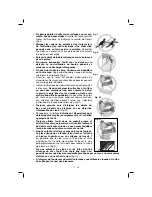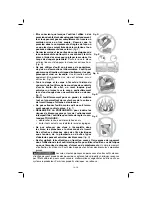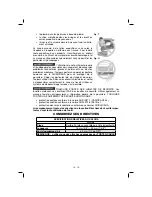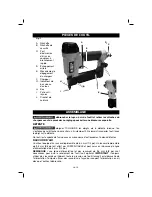
5 - ENG
• Grip tool firmly to maintain control while allowing tool
to recoil away from work surface as fastener is driven.
• Do not actuate the tool unless the tool is placed firmly
against the workpiece.
(Fig. T)
• DEPTH ADJUSTMENT: To reduce risk of serious injury
from accidental actuation when attempting to adjust
depth, ALWAYS:
• Disconnect air supply.
• Avoid contact with trigger during adjustments.
• Do not drive nails blindly into walls, floors or other
work areas.
Fasteners driven into live electrical wires,
plumbing, or other types of obstructions can result in
injury.
(Fig. U)
• Stay alert, watch what you are doing and use common
sense when operating a power tool. Do not use tool
while tired or under the influence of drugs or alcohol.
A moment of inattention while operating power tools may
result in serious personal injury.
Some dust created by power sanding, saw-
ing, grinding, drilling, and other construction activities con-
tains chemicals known to the State of California to cause
cancer, birth defects or other reproductive harm. Some
examples of these chemicals are:
• lead from lead-based paints,
•
crystalline silica from bricks and cement and other
masonry products, and
• arsenic and chromium from chemically-treated lumber.
Your risk from these exposures varies, depending on how
often you do this type of work. To reduce your exposure to
these chemicals: work in a well ventilated area, and work
with approved safety equipment, such as those dust masks
that are specially designed to filter out microscopic particles.
Use of this tool can generate and/or disburse
dust, which may cause serious and permanent respiratory or
other injury. Always use NIOSH/OSHA approved respiratory
protection appropriate for the dust exposure. Direct particles
away from face and body. Always operate tool in well-
ventilated area and provide for proper dust removal. Use
dust collection system wherever possible.
ALWAYS USE SAFETY GLASSES. Everyday
eyeglasses are NOT safety glasses. Also use face or dust
mask if operation is dusty. ALWAYS WEAR CERTIFIED
SAFETY EQUIPMENT:
• ANSI Z87.1 eye protection (CAN/CSA Z94.3),
• ANSI S12.6 (S3.19) hearing protection,
• NIOSH/OSHA respiratory protection.
Before operating this tool, carefully read all instructions
in
Important Safety Instructions
.
Fig. Q
Fig. R
Fig. S
Fig. P
Fig. T
Fig. U




































